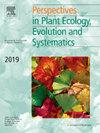传粉效率与花粉-胚珠比关系的厘清
IF 2.9
3区 环境科学与生态学
Q1 ECOLOGY
Perspectives in Plant Ecology Evolution and Systematics
Pub Date : 2025-04-29
DOI:10.1016/j.ppees.2025.125872
引用次数: 0
摘要
直觉表明,在传播过程中花粉的损失将有利于增加花粉产量来抵消损失。然而,从性别分配理论的角度来看,这种损失构成了亲本投入后的死亡率,理论模型一致表明,投入后死亡率的性别差异对亲本性别分配没有选择性影响,其中花粉和胚珠投入是一个显著的部分。这种直觉和理论之间的冲突可以通过与动物生殖生态学的比较来改善。像一夫多妻制这样的交配制度会留下许多看似多余的雄性,这不利于性别比例的补偿性调整。在广播产卵者中,猖獗的卵死亡率并没有为更大的卵产量创造选择。这些低效的生殖投资之所以会进化,是因为效率并不是支配性别分配的稀有性别优势的基础。尽管如此,授粉效率与花粉-胚珠比例的经验关联需要解释。一种简单但未被探索的可能性是,高授粉效率往往还涉及相关花粉群的柱头沉积或焦点供体对附近受体植物的重复授粉,从而产生局部交配竞争,这是一个长期以来已知的影响性别分配的因素。这一假说预测,低花粉-胚珠比例将伴随着高水平的相关父系。本文章由计算机程序翻译,如有差异,请以英文原文为准。
Untangling the relationship between pollination efficiency and pollen-ovule ratios
Intuition suggests that loss of pollen during dispersal will favour increased pollen production to counteract the loss. From the perspective of sex allocation theory, however, such loss constitutes mortality following parental investment, and theoretical models have consistently shown that sex differences in post-investment mortality have no selective effect on parental sex allocation, of which pollen and ovule investment is a conspicuous part. This conflict between intuition and theory can be ameliorated by comparison to animal reproductive ecology. Mating systems such as polygyny that leave many seemingly superfluous males do not favour compensatory adjustments in the sex ratio. Rampant egg mortality among broadcast-spawners does not create selection for greater egg production. These inefficient reproductive investments evolve because efficiency is not the basis of the rare-sex advantage governing sex allocation. Nonetheless, empirical associations of pollination efficiency with pollen-ovule ratios need explanation. A simple but unexplored possibility is that high pollination efficiency tends also to involve stigmatic deposition of related cohorts of pollen or repeated pollination of nearby recipient plants by a focal donor, thus creating local mating competition, a factor long known to affect sex allocation. This hypothesis predicts that low pollen-ovule ratios will be accompanied by high levels of correlated paternity.
求助全文
通过发布文献求助,成功后即可免费获取论文全文。
去求助
来源期刊
CiteScore
6.50
自引率
0.00%
发文量
28
审稿时长
67 days
期刊介绍:
Perspectives in Plant Ecology, Evolution and Systematics (PPEES) publishes outstanding and thought-provoking articles of general interest to an international readership in the fields of plant ecology, evolution and systematics. Of particular interest are longer, in-depth articles that provide a broad understanding of key topics in the field. There are six issues per year.
The following types of article will be considered:
Full length reviews
Essay reviews
Longer research articles
Meta-analyses
Foundational methodological or empirical papers from large consortia or long-term ecological research sites (LTER).

 求助内容:
求助内容: 应助结果提醒方式:
应助结果提醒方式:


